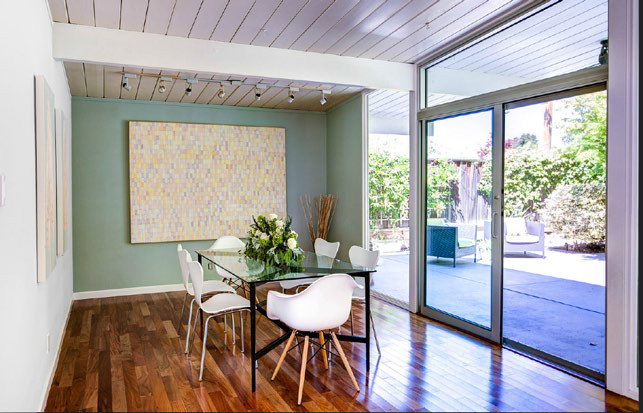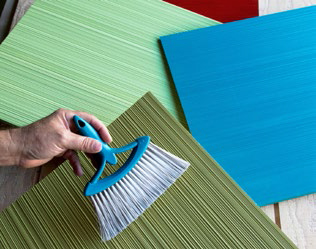Walls that Sing - Page 3
 |
|
|
 |
|
|
Tips for restoration
Lou Palladino, whose Palladino Painting services Eichlers from Burlingame to San Jose, says many of his customers will try to restore their paneling if they are intent on retaining the original look of their home.
If the paneling is salvageable, Palladino will prepare the walls with a cleaning and a light sanding, being careful not to wear through the thin veneer. He follows with a toned polyurethane to restore the color and add richness. The urethane helps to blend in damaged areas and soften the overall look.
For original wood paneling that can't be restored, or for homeowners who want to add a different kind of personality to their spaces, Palladino points to painting as a practical option.
"For painting, we prepare the paneling by sanding, cleaning, and sealing with an oil-based primer," he says. "If a homeowner likes, we can also conceal the vertical wood joints by taping them. To do this, we fill the joints with joint compound, lay a thin film of the compound over the joint, and then imbed joint tape in it."
If your panels are already painted, damaged, or removed, installing new wood finishes on walls is a modern way of adding natural texture to drywall. "It is easy and not very expensive to find new paneling [similar but not identical to the Eichler originals], or purchase used ones if you search a bit on online forums," Glessner says. There are also a number of other options.
Weldtex midcentury revival
Eichler Siding's Jeff Nichols expanded his business as Vintage Plywood Millworks, manufacturing interior paneling after fielding hundreds of inquiries about how to restore or replace wood veneers. He discovered, among other things, that paneling is a challenge for many homeowners since the same kind of mahogany used in the mid-century is no longer available, and the mahogany veneers on the market just don't have the same look.
After considerable research, Nichols began producing Weldtex, also called combed or striated wood. Most commonly produced in the mid-century in 3/8-inch-thick pine plywood, it was a common interior wall application in homes across the United States from the 1940s through the 1960s.
The Weldtex panels fit together seamlessly and are simple for a contractor or even a homeowner to install. Starlight Village, a new development of MCM-style homes near Austin, Texas, recently incorporated Nichols' Weldtex paneling into their interiors.
"A lot of Eichler folks are trying to come up with ways to stay true to the mid-century period," says Nichols. "And if they can get past the idea of painting paneling, Weldtex is a great option.
"Weldtex is far better painted than stained—and that's what Starlight Village did, with MCM colors."
"I really like those panels, as they are in sync with the Eichler style, seamless—and they provide a modern textured version of plywood or wood paneling," adds Glessner.
When used as an accent wall, the Weldtex pattern sports an appealing retro look—"and it looks great on tiki bars too," says Nichols.
Photography: Sabrina Huang, David Toerge; and courtesy Modern Homes Realty




